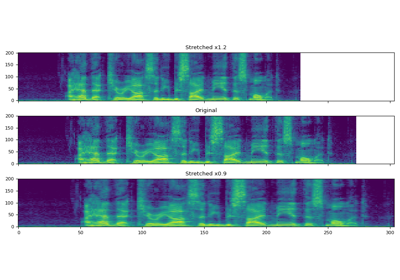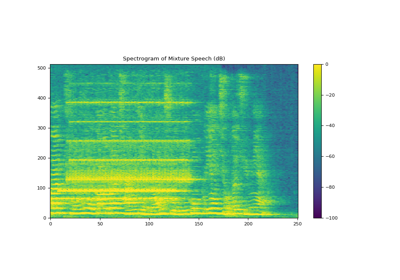逆谱图¶
- class torchaudio.transforms.InverseSpectrogram(n_fft: int = 400, win_length: ~typing.Optional[int] = None, hop_length: ~typing.Optional[int] = None, pad: int = 0, window_fn: ~typing.Callable[[...], ~torch.Tensor] = <built-in method hann_window of type object>, normalized: ~typing.Union[bool, str] = False, wkwargs: ~typing.Optional[dict] = None, center: bool = True, pad_mode: str = 'reflect', onesided: bool = True)[source]¶
创建一个逆谱图,用于从谱图中恢复音频信号。
- 参数:
n_fft (int, 可选) – FFT 大小,创建
n_fft // 2 + 1个 bin。(默认值:400)win_length (int 或 None, 可选) – 窗口大小。(默认值:
n_fft)hop_length (int 或 None, 可选) – STFT 窗口之间的跳跃长度。(默认值:
win_length // 2)pad (int, 可选) – 信号的双边填充。(默认值:
0)window_fn (Callable[..., Tensor], 可选) – 一个函数,用于创建应用于/乘以每个帧/窗口的窗口张量。(默认值:
torch.hann_window)normalized (bool 或 str, 可选) – STFT 输出是否按幅度归一化。如果输入为 str,可选值为
"window"和"frame_length",取决于归一化模式。True对应于"window"。(默认值:False)wkwargs (dict 或 None, 可选) – 窗口函数的参数。(默认值:
None)center (bool, 可选) – 谱图中的信号是否在两侧进行了填充,以便第 \(t\) 帧以时间 \(t \times \text{hop\_length}\) 为中心。(默认值:
True)pad_mode (string, 可选) – 控制当
center为True时使用的填充方法。(默认值:"reflect")onesided (bool, 可选) – 控制是否使用谱图返回一半结果以避免冗余。(默认值:
True)
- 示例
>>> batch, freq, time = 2, 257, 100 >>> length = 25344 >>> spectrogram = torch.randn(batch, freq, time, dtype=torch.cdouble) >>> transform = transforms.InverseSpectrogram(n_fft=512) >>> waveform = transform(spectrogram, length)
- 使用
InverseSpectrogram的教程


